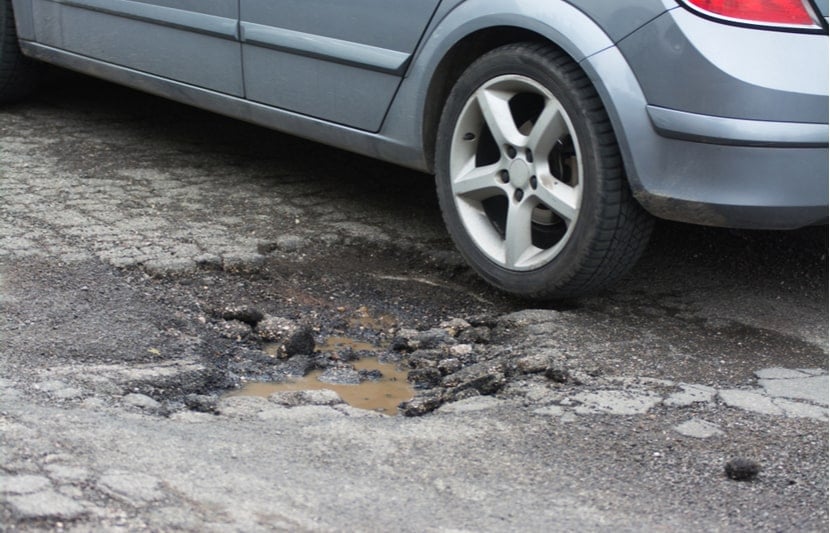Pothole reports are up by 24% since 2020 and 1 in 5 motorists have damaged their car because of potholes. You can claim for pothole damage from your local council, but according to our research, payouts are down by 13%. And motorists are finding it increasingly difficult to claim from their local councils.
In this guide, we’ll look at how much damage potholes have caused to cars and how you can claim for damage.

Why is the UK’s pothole problem so bad?
Potholes could be getting worse because of the amount of rain and stormy weather we’re getting in the UK. It might also be because there’s more traffic on the road.
There was also a shortage of bitumen in 2022 - a key ingredient of tarmac. The shortage caused more delays to pothole repairs.
In 2023, the government announced a £200 million fund to help fix the UK’s pothole problem as part of the budget announcement.
But some local councils had more of the £200 million than others. This could be why some areas have more potholes. The fund is being put to good use in some parts of the UK though. Councils fixed 1.2 million potholes in the UK in 2023, this is up by 19% compared to 2020.
But motorists are reporting nearly the same amount of potholes every year, so it’s still an issue for drivers.
Even with the new fund, drivers aren’t satisfied with the state of UK roads. Almost half (48%)** of the drivers we asked want the government to put more money towards pothole repairs.
Over half (53%) think it should be a legal requirement for councils to repair a pothole after it’s been reported.
"Although the harsh winter months are almost behind us, potholes are still proving problematic for drivers across the UK. That’s as our latest data reveals how roads are seemingly getting worse, with around 1 million potholes reported last year - a 24% increase compared to 2020.
“There’s no denying that the UK has a pothole problem, and the government has dedicated more funding as a result. But for some drivers this isn’t enough. Especially if they live in high risk areas, where wet and colder weather means problems are more likely to arise.”
What our motor insurance expert says

Which region in the UK is the worst for potholes?
We collected pothole reporting data and found the worst places in the UK for potholes:
| Region | Number of reported potholes in 2023 |
|---|---|
|
South East England
|
194,675
|
|
South West England
|
173,183
|
|
Scotland
|
123,311
|
|
North West England
|
104,524
|
|
East Midlands
|
69,011
|
But some areas in the UK seen a bigger rise in potholes than others since 2020. In Yorkshire and the Humber, potholes reports are up by 63% since 2020.
There were 54,000 potholes reports last year, that’s a 53% increase since 2020. The pothole figures in Wales are up by 31%, with drivers reporting more than 33,000 potholes.
What’s the most common damage caused by potholes?
Tyres are the most commonly damaged by potholes, with more than half (57%) reporting a puncture or flat tyre.
More than a third (35%) said potholes damaged their suspension. Another third (32%) said their car’s tracking was affected by pothole damage.
It cost drivers around £169 to fix this damage on average.
Who's responsible for pothole damage to my car?
Your local council is responsible for pothole damage, so you should always go to your local council first before claiming on your car insurance. They have a responsibility to maintain roads in their area.
But less than 1 in 5 (17%) tried to claim back repair costs from their local council. These drivers said they found the process either stressful (42%) or long-winded (30%). This could be why people decided to repair the damage themselves.
Those that were successful managed to get back £214 on average to cover the cost of pothole damage. Roads that cross several authority areas, such as motorways and A-roads, come under the charge of:
- England: Highways England
- Northern Ireland: Department for Infrastructure
- Scotland: Transport Scotland
- Wales: Traffic Wales
If your car is damaged as a result of running over a pothole, your local authority or one of the 4 national authorities could be liable. But if your car is damaged due to other debris on the road, you aren’t entitled to compensation. For this, you need to make a claim on your car insurance policy.
How do I make a pothole claim?
Drivers made a total of 4.4 million claims for pothole-related damage in 2023. That’s up by 6% in comparison to 2020.
To make a successful pothole claim, you need to show evidence of pothole damage to your car. Here’s what you need to do:
-
Check the damage caused by the pothole
-
Gather evidence
-
Report the pothole
-
Get a mechanic to confirm pothole damage and get repair quotes
-
Submit your pothole claim
“If your car is damaged due to a pothole, you should always try to reclaim the cost of damage through the council first. That’s because pothole repairs are their responsibility. When making a claim, make sure to take pictures or videos for evidence and be as detailed as you can.
“You should share information about where the pothole was, the time of day it happened and the damage it caused your car. And if the local council won’t compensate for damages, you could also make a claim through your car insurance. But be wary that this could result in a higher premium the following year, so always try the council first.”
What our motor insurance expert says

1. Check the damage caused by the pothole
As soon as you're aware that a pothole may have damaged your car, find a safe place to pull over. Check if there’s any visible pothole damage to your wheels and tyres. While you’re driving you also need check:
-
Whether the car is making any vibrations
-
How the steering feels
-
Whether the car is veering to one side
If there are any problems, get your car to a garage or tyre centre as soon as possible.
2. Gather evidence
You need to show the local authority pictures of the pothole. If you’re returning after the incident to take photos, bring a measuring tape and use that to show its size. If that’s not an option, placing an everyday object you have like a shoe or bag can give a good indication of scale. It’s also important to make a note of:
-
The date and time of the incident
-
Any witnesses and their contact details
-
The location of the pothole on the road
-
The damage to your car
-
If you visit a garage and they find more damage
3. Report the pothole
You need to tell the body responsible for maintaining the road about the pothole. For local roads, B roads and minor A roads that’s likely to be the local authority. To find the right council, use the report a pothole tool on the government website.
For more major roads you have to report it to the relevant national authority.
Even if you don’t make a claim or your car isn’t damaged you should still report the pothole to your council straight away. It could help protect other drivers from damaging their car.
What counts as a pothole?
A pothole is usually classified as 4 cm deep and between 20 -30 cm wide. Every council’s definition varies, but most use these measurements to determine potholes. If the hole has smaller dimensions than this it's probably classified as a ‘carriageway defect’, which is the same thing, just under a different name. According to our data, drivers reported almost 1 million potholes in 2023.
4. Get a mechanic to confirm pothole damage and get repair quotes
Ask the mechanic to confirm the cause of the damage in writing. You need this to be able to make your pothole claim from the local authority. It’s also worth getting quotes from at least 3 garages. Keep a record of each and go with the cheapest. Showing willingness to keep repair costs down could help your pothole claim.
5. Submit your pothole claim
When you’re ready to claim for pothole damage, contact the local authority you reported the pothole to.
Make it clear that you’re looking to make a claim for pothole compensation and pass on:
- A full description of the incident
- When and where it happened
- What you’ve done since to address the damage to your car
Don’t forget to include:
-
Copies of photos
-
Witness details
-
Confirmation of pothole damage from the mechanic
-
Quotes
-
Repairs for damage
-
Any other details that could help your claim
Your right to pothole compensation has limits. You need to prove that the local authority failed in its duty to maintain the road, in accordance with Section 58 of the Highways Act 1980.
What happens after I've made a pothole claim?
The local authority is obligated to respond to any claim lodged with them within 30 days. If they don’t, contact them again via the complaints department.
They should get back to you with one of the following reactions:
- The authority accepts your claim and covers all your repair expenses. It probably won’t stretch to additional expenses such as alternative transport.
- The authority offers a partial settlement.
- The authority rejects the claim in its entirety.
If the local authority offers a partial settlement, you can give them a counter offer.
Reaffirm the costs you’ve incurred directly as a result of the incident, and show that you’ve shopped around for the cheapest repairs.
Some claims could take months to resolve. You might also need to be persistent if you’re only offered a partial settlement or you think your claim has been incorrectly rejected.
What if my pothole claim is rejected?
Around a third (31%) who tried to claim pothole damage were unsuccessful in getting compensation. Your claim for pothole damage is likely to be rejected if:
-
It was actually the result of debris on the road
-
If the pit in the road wasn't large enough to be a pothole
If your pothole claim is rejected, you have a few options. Either:
- Accept the rejection
- Take the authority to small claims court
- Claim on your car insurance policy
- If the damage to your car is little more than a burst tyre, you could accept the rejection and pay for repairs yourself
If the pothole damaged or destroyed your catalytic convertor, the costs involved are likely to be high enough to pursue the claim further.
Taking the authority to small claims court is an option, but it's not cheap. If you decide to go down this route, it's worth getting independent legal advice.
You could put in a Freedom of Information Act request to establish whether the council actually inspected the site. They’re required to do so, but might not have.
If the court route doesn’t appeal – and it can be pricey if you use a lawyer and lose – you could claim on your car insurance. Your insurer might consider this an ‘at-fault’ claim, so it could impact your no-claims discount and your future insurance costs.
*A Freedom of Information request was sent to UK councils on 7th December 2023. Each council was asked to answer the following questions:
-
The total number. of potholes reported in your council area for the years 2020, 2021, 2022 and 2023 to date
-
The total number of potholes fixed in your council area for the years 2020, 2021, 2022 and 2023 to date
-
The total amount made in claims for compensation due to pothole damage broken down by financial year for the years 2020/21, 2021/22, 2022/23, and 2023/24 to date
-
The total amount paid out in claims for compensation due to pothole damage broken down by financial year for the years 2020/21, 2021/22, 2022/23, and 2023/24 to date
-
The road name in your area which has received the most pothole reports over the past 5 years, and the total amount of reports made.
Of the 320 UK councils responsible for potholes, 291 responded to the request.
**Unless otherwise stated, all research was carried out by OnePoll on behalf of Confused.com. A survey of 2,000 UK drivers was conducted between 5 and 9 February 2024.








